Explore Zhujiajiao - China Travel, Asia
Tucked away just an hour from the bustling metropolis of Shanghai lies Zhujiajiao, an ancient water town that feels like a journey back in time. Often referred to as the “Venice of the East,” this quaint town is well-known for its tranquil canals, old architectural bridges, and historically significant buildings. With a history spanning over 1,700 years, Zhujiajiao offers a peaceful retreat from the city's fast pace, making it a popular destination for both day-trippers and those seeking a deeper cultural experience. For travelers eager to explore beyond Shanghai's skyscrapers, Zhujiajiao is the perfect escape, offering a glimpse into China's past while embracing the charm of a water town still alive with local life.
Population: Approximately 95,000 in 2017.
Economy: Tourists are the main driver of Zhujiajiao's economy, which is fueled by vibrant marketplaces, handcrafted goods, and small enterprises in this quaint lake town.
Landmarks: Famous for the Fangsheng Bridge, Ke Zhi Yuan Garden, and Yuanjin Buddhist Temple.
China
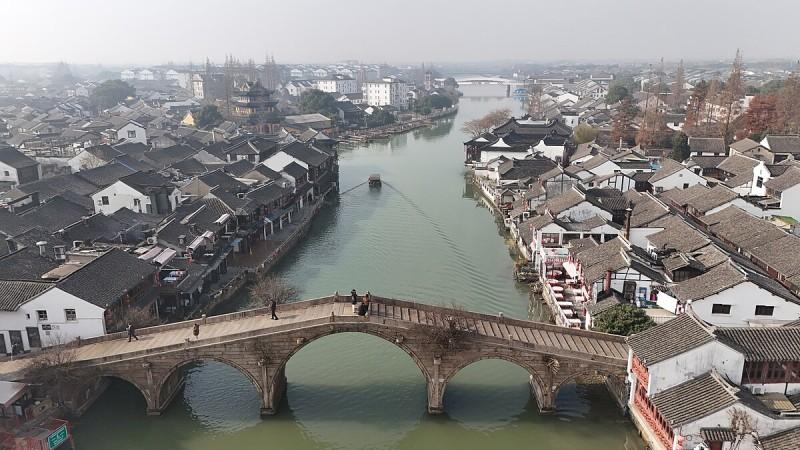
Overview of Zhujiajiao
History & Cultural Influence
Zhujiajiao’s roots stretch back over 1,700 years, to a time when it was a vibrant market town during the Yuan Dynasty. It flourished particularly during the Ming and Qing Dynasties, becoming a bustling hub of commerce and culture. The town’s strategic location on the banks of Dianshan Lake and its network of canals made it a crucial center for trade. Zhujiajiao is also a live representation of Jiangnan's cultural heritage. The town’s architecture, with its whitewashed walls and black-tiled roofs, reflects traditional Jiangnan aesthetics. The influence of Confucianism, Buddhism, and Taoism is evident in the town’s temples, gardens, and everyday life.
Interaction with The Locals
Zhujiajiao, with a population of approximately 95,000 residents, is a vibrant community that blends tradition with modern life. The citizens, primarily Han Chinese, are known for their warm hospitality and strong connection to the town's rich cultural heritage. Many locals are involved in traditional crafts, agriculture, and small businesses, contributing to the town's authentic and welcoming atmosphere. Despite its growing popularity as a tourist destination, Zhujiajiao retains a close-knit, community-oriented spirit, where residents take pride in preserving their customs and way of life.
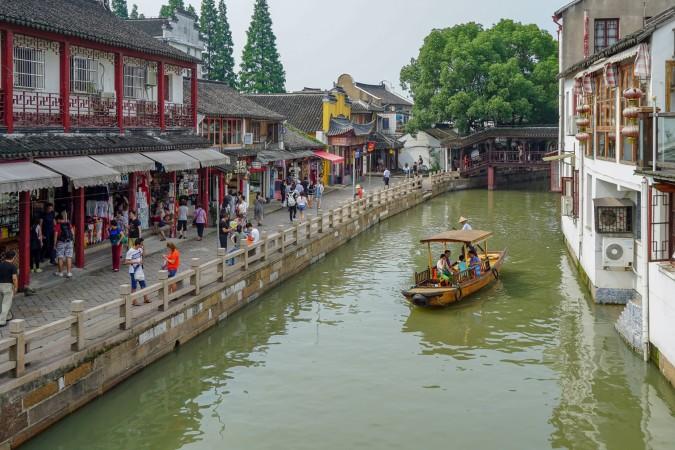
Zhujiajiao's canals - © iStock
Top Attractions in Zhujiajiao
Must-Visit Sites in Zhujiajiao
Zhujiajiao is a treasure trove of historic and cultural sites that are must-sees for any visitor.
- Fangsheng Bridge: As the largest stone arch bridge in Zhujiajiao, Fangsheng Bridge is an iconic landmark. Built during the Ming Dynasty, this bridge is famous for its graceful arches and the dragon carvings that guard its ends. It’s also a popular spot for locals and tourists alike to release fish into the river below—a traditional act of mercy in Buddhist culture.
- Ke Zhi Yuan Garden: Known as the “Ma Family Garden,” this classical garden is a fine example of traditional Chinese landscape design. The garden’s name, which means “learning to plant trees,” reflects its original owner’s aspiration to cultivate not just plants, but also knowledge and virtue. The garden features pavilions, ponds, and rockeries, all arranged in perfect harmony, offering a peaceful retreat from the outside world.
Lesser-Known Attractions in Zhujiajiao
While Zhujiajiao’s main sites draw much attention, the town is also home to lesser-known gems that offer a deeper dive into its rich culture and vibrant daily life.
- Yuanjin Buddhist Temple: Nestled along the banks of the Caogang River, Yuanjin Buddhist Temple is a peaceful retreat where visitors can experience the spiritual side of Zhujiajiao. The temple, dedicated to Guanyin, the goddess of mercy, features intricately carved statues, tranquil courtyards, and halls filled with the scent of burning incense.
- Handicraft Lane: This lively street is a haven for lovers of traditional Chinese arts and crafts. Handicraft Lane is lined with small shops where artisans create and sell their handmade goods. Here, you can find beautifully crafted silk products, detailed paper-cut art, and traditional Chinese clothing.
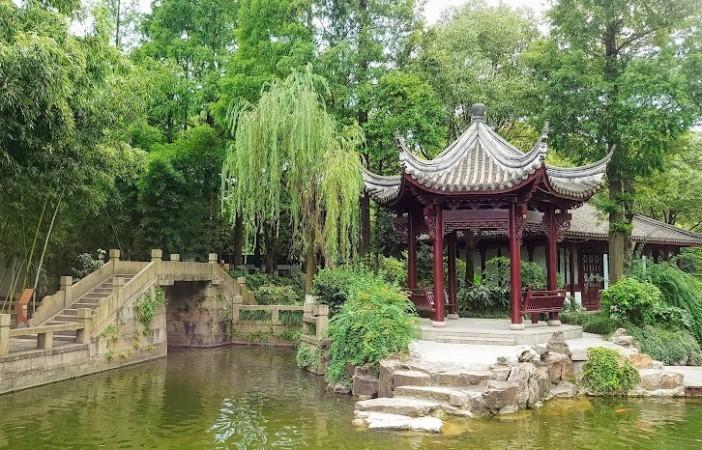
Ke Zhi Yuan Garden - © Vietjet Air
Must-Try Dishes in Zhujiajiao
Zhujiajiao’s cuisine is a delightful reflection of its rich cultural heritage, offering a range of traditional dishes that are a feast for both the eyes and the palate. These dishes not only provide a taste of Zhujiajiao’s culinary heritage but also offer a chance to experience the town’s vibrant food culture firsthand.
- Zongzi: This traditional sticky rice dumpling is a staple in Zhujiajiao. Wrapped in bamboo leaves and steamed to perfection, zongzi is typically filled with savory ingredients like pork, mushrooms, and salted egg yolk. It’s often enjoyed during festivals but is available year-round in local eateries.
- Braised Pork in Soy Sauce: Known for its rich flavor and tender texture, this dish features chunks of pork belly slow-cooked in a savory soy sauce mixture. The slow braising process ensures the meat is infused with a deep, complex flavor, making it a beloved comfort food in Zhujiajiao.
- Local River Shrimp: Freshly caught from the town’s canals, these river shrimp are typically prepared with minimal seasoning to highlight their natural sweetness. A simple stir-fry or a quick boil brings out their delicate flavor, making them a popular choice among locals and visitors alike.
- Tea-Smoked Duck: This dish combines the smokiness of tea leaves with the rich flavor of duck. The meat is marinated, smoked with tea leaves, and then steamed, resulting in a unique and aromatic flavor that captures the essence of traditional Chinese cooking.
- Jujube Cake: For a sweet treat, try jujube cake. Made with dates, this traditional dessert has a chewy texture and a sweet, rich flavor. It’s a popular choice for those looking to end their meal on a satisfying note.
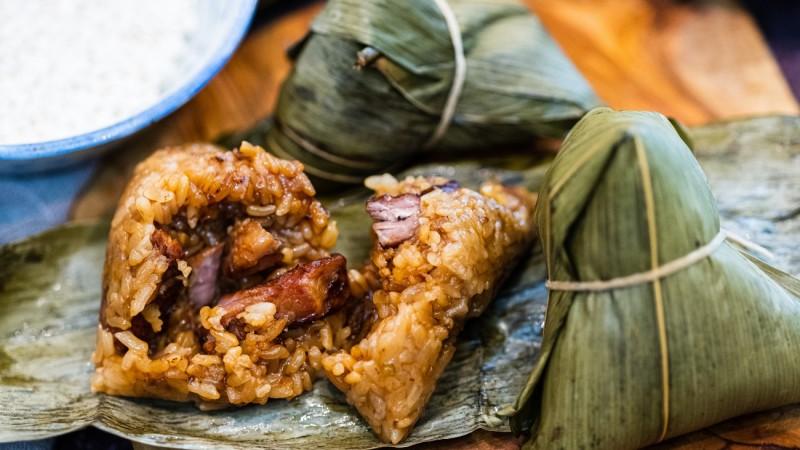
Zongzi - © Curated Kitchenware
Festivals & Local Celebrations
Zhujiajiao is not only a treasure trove of historical and cultural attractions but also a lively hub for traditional festivals and local celebrations. These events offer visitors a chance to immerse themselves in the town’s vibrant culture and festive spirit.
- Dragon Boat Festival: Held on the 5th day of the 5th lunar month, the Dragon Boat Festival is a highlight of Zhujiajiao’s annual calendar. This colorful event features exciting dragon boat races on the town’s canals, where teams of rowers compete in beautifully decorated boats. The festival also includes the traditional practice of eating zongzi, adding to the festive atmosphere.
- Lantern Festival: Celebrated on the 15th day of the Chinese New Year, the Lantern Festival in Zhujiajiao is a visual feast. The town comes alive with lantern displays of various shapes and sizes, illuminating the streets and waterways. Visitors can enjoy lantern parades, traditional performances, and festive foods during this enchanting celebration.
- Mid-Autumn Festival: This festival, held on the 15th day of the 8th lunar month, is a time for family reunions and celebrating the harvest. In Zhujiajiao, the festival is marked by mooncake tastings, lantern displays, and cultural performances. The sight of mooncakes and lanterns adds a festive touch to the town’s picturesque landscape.
- Traditional Folk Arts Festival: Zhujiajiao also hosts a traditional folk arts festival, showcasing local crafts, music, and dance. This festival offers visitors a chance to see traditional Chinese art forms in action and engage with local artisans and performers.
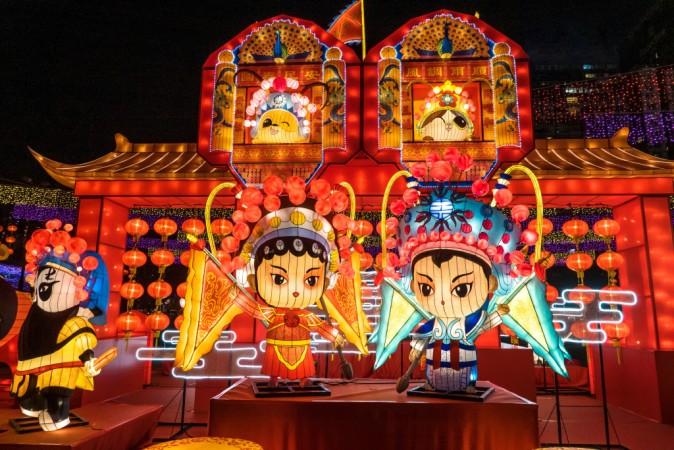
Mid-Autumn Festival - © CGTN
What to Do in Zhujiajiao
Zhujiajiao offers a diverse array of activities that cater to different interests, making it an engaging destination for visitors. These activities ensure that your visit to Zhujiajiao is both enjoyable and immersive, offering a range of experiences that showcase the town’s historical charm and cultural vibrancy.
- Zhujiajiao Canals Boat Ride: Glide through Zhujiajiao’s picturesque canals on a traditional boat. This relaxing ride offers a unique vantage point to admire the town’s historic architecture, scenic bridges, and tranquil waters. It's a calmer approach to appreciate Zhujiajiao's charm and beauty.
- Zhujiajiao Cycling Tours: Rent a bicycle and venture through the town’s scenic streets and countryside. Cycling is an excellent way to explore Zhujiajiao at your own pace, uncovering hidden gems, ancient bridges, and rural landscapes that are off the beaten path.
- Capture Stunning Photos: Zhujiajiao’s enchanting scenery makes it a photographer’s paradise. Take in the town's recognizable bridges, historic buildings, and vibrant marketplaces. The best times for photography are early morning and late afternoon, when the light beautifully illuminates the canals and historic buildings.
- Participate in Local Workshops: Engage in hands-on experiences by joining local workshops. Learn about traditional Chinese crafts such as silk weaving, paper cutting, or tea ceremonies. These workshops provide a deeper understanding of Zhujiajiao’s cultural heritage and allow you to try your hand at age-old skills.
- Stroll Through the Markets: Wander through Zhujiajiao’s lively markets to experience the local atmosphere. Browse for souvenirs, taste street food, and observe daily life in this vibrant setting. The markets are also a great place to interact with local vendors and see the town’s daily hustle and bustle.
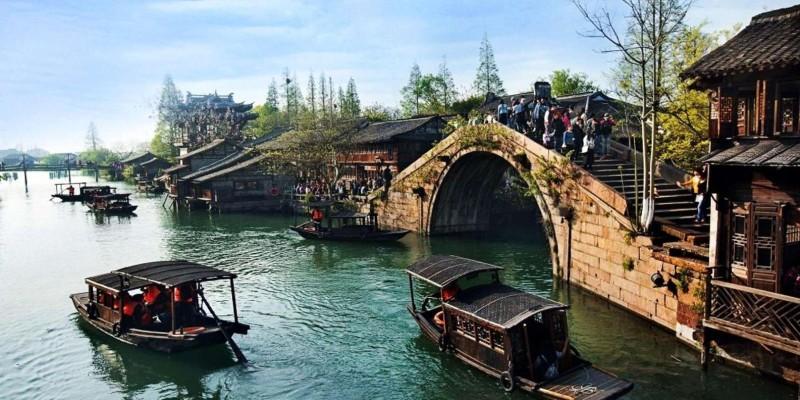
Zhujiajiao Canals Boat Ride - © China Tourism
Weather in Zhujiajiao: Best Time to Visit
Zhujiajiao experiences a humid subtropical climate with four distinct seasons, each offering its own unique charm for tourists. Each season in Zhujiajiao presents different opportunities and experiences, allowing visitors to enjoy the town's beauty and culture throughout the year.
Spring in Zhujiajiao
Spring in Zhujiajiao is mild and pleasant, with temperatures ranging from 12°C to 22°C (54°F to 72°F). This season is ideal for outdoor activities and exploring the town’s scenic beauty. The blooming flowers and mild weather attract many visitors, making it a popular time for sightseeing and canal tours. Spring is also a great time for photography, as the town’s landscapes are lush and vibrant.
Summer in Zhujiajiao
Zhujiajiao experiences hot, muggy summers that frequently reach temperatures beyond 30°C (86°F). Along with periodic rain showers, this season also brings sporadic thunderstorms. While the heat can be intense, it’s a great time to enjoy water-based activities like boat rides and canal tours. The summer months are also when local festivals and cultural events take place, offering vibrant experiences for tourists despite the weather challenges.
Autumn in Zhujiajiao
Autumn is one of the best times to visit Zhujiajiao. The weather is cool and comfortable, with temperatures ranging from 15°C to 25°C (59°F to 77°F). The fall foliage adds a picturesque touch to the town’s canals and streets, making it an excellent time for outdoor exploration and scenic photography. The pleasant weather also means fewer tourists compared to the spring, providing a more relaxed experience.
Winter in Zhujiajiao
Winters in Zhujiajiao are generally cold and damp, with temperatures ranging from 2°C to 10°C (36°F to 50°F). While snowfall is rare, the chill in the air makes it essential to dress warmly. Winter is a quieter time for tourism, offering a peaceful atmosphere and fewer crowds. This season is ideal for those who enjoy a tranquil experience and the opportunity to explore the town’s attractions without the bustling summer crowds.
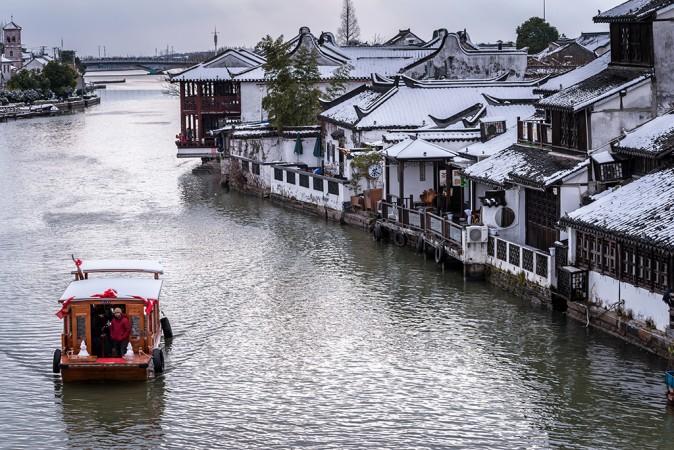
Zhujiajiao in winter - © China Daily
Shopping in Zhujiajiao
Shopping in Zhujiajiao is a delightful experience that lets you bring home a piece of the town’s rich cultural tapestry and craftsmanship.
- Local Markets: Browse fresh produce, sample traditional snacks, and discover unique souvenirs. These vibrant markets are perfect for experiencing the town’s daily life and picking up local treats.
- Artisan Crafts: Handicraft Lane is a must-visit for high-quality silk items, intricate paper-cut art, and unique ceramics. These handcrafted goods reflect Zhujiajiao’s rich cultural heritage and make for memorable gifts.
- Tea Products: Zhujiajiao is known for its tea culture, and local tea shops offer a selection of fine teas. From delicate green teas to robust black teas, these shops provide an opportunity to taste and purchase premium teas that capture the essence of Chinese tea traditions.
- Silk Goods: For elegant souvenirs, visit Zhujiajiao’s silk stores. You’ll find beautifully made silk clothing, scarves, and accessories. These products provide a hint of elegance and heritage and are made from premium materials.
- Antiques Stores: History enthusiasts will enjoy exploring antique stores in Zhujiajiao. Discover vintage coins, old stamps, and traditional household items that provide a glimpse into the town’s past.
Essential Travel Information
Getting Around Zhujiajiao
Navigating Zhujiajiao is convenient with various transportation options that cater to different needs. Each mode of transportation offers its own advantages, allowing you to experience Zhujiajiao in a way that best suits your preferences and itinerary.
- Public Buses: Zhujiajiao is served by a network of public buses that connect major areas within the town and to nearby cities. Buses are a cost-effective way to travel, with routes that cover key attractions and transportation hubs.
- Taxis: Taxis are readily available and offer a convenient way to travel around Zhujiajiao. They are especially useful for reaching destinations that are not easily accessible by public transportation. Ensure that the taxi is licensed and consider using ride-hailing apps for ease of booking.
- Boats: Traditional boats are a popular mode of transport along Zhujiajiao’s canals. Boat rides provide a unique perspective of the town’s historic sites and are a pleasant way to explore the scenic waterways.
- Bicycles: Renting a bicycle is a great way to explore Zhujiajiao at your own pace. The town’s flat terrain and scenic routes make cycling a convenient and enjoyable option for sightseeing.
- Walking: Many of Zhujiajiao’s attractions are within walking distance of each other. You may take your time strolling about the town's picturesque streets, storied buildings, and vibrant marketplaces.
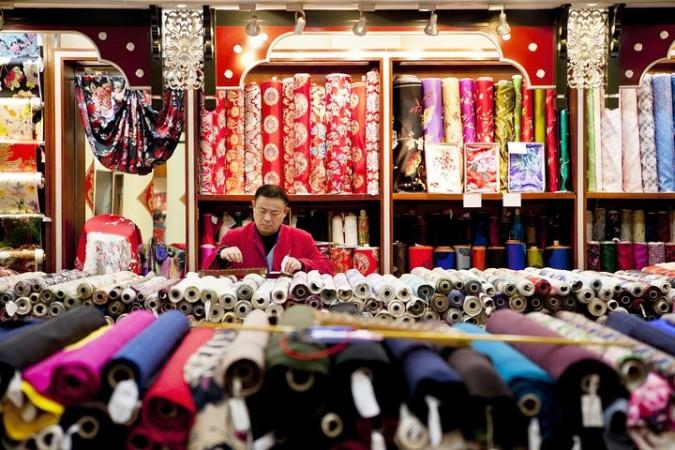
Silk shops in Zhujiajiao - © iStock
ATM & Banking Services
Zhujiajiao offers various banking services to cater to both locals and visitors. ATMs are conveniently located throughout the town, especially in major tourist areas and commercial zones, and accept most international credit and debit cards for easy cash withdrawals. Currency exchange is available at banks, some hotels, and travel agencies, with ATMs providing a practical option for obtaining local currency. While most local businesses, including hotels, restaurants, and shops, accept major credit cards, it's wise to carry some cash for smaller transactions or places that may not accept cards.
Where to Stay in Zhujiajiao
Zhujiajiao offers a variety of accommodation options to suit different preferences and budgets. Whether you’re looking for luxury or a cozy guesthouse, you’ll find suitable choices.
- Luxury Hotels: These establishments offer premium amenities, including spacious rooms, fine dining, and spa services. They are often located near major attractions, providing both comfort and convenience.
- Guesthouses and Inns: For a more budget-friendly option, guesthouses and inns provide a cozy and affordable stay. These accommodations often offer a homely atmosphere and can be a great way to experience local hospitality.
- Hostels: If you’re traveling on a budget or prefer a social environment, hostels are available in Zhujiajiao. They offer basic amenities and opportunities to meet fellow travelers, making them a good choice for younger or solo travelers.
Articles for you

Explore Yala National Park - Sri Lanka Travel, Asia
Tucked away in Sri Lanka’s southeastern corner, Yala National Park is where wild nature meets deep tradition. Known worldwide for its leopard population, the park is also home to elephants, sloth bears, crocodiles, and hundreds of bird species. Beyond wildlife, Yala opens doors to a cultural landscape dotted with ancient temples, Buddhist ruins, and coastal villages. For travelers seeking more than just a safari, Yala offers a chance to explore eco-tourism, local communities, and sacred heritage sites.
Population: The Yala National Park area doesn’t have a human population.
Economy: The economy around Yala National Park thrives on a blend of eco-tourism, agriculture, and local services. Safari tours, eco-lodges, and cultural experiences drive steady income for nearby towns like Tissamaharama and Kataragama, supporting thousands of families.
Landmarks: Famous for Block I of Yala and wildlife encounters, including elephants, sloth bears, crocodiles, and exotic bird species.

Explore Galle - Sri Lanka Travel, Asia
Nestled on Sri Lanka’s southern coastline, Galle is a vibrant city where history meets the sea. Its cobbled streets, colonial architecture, and serene beaches make it a must-visit destination for travelers seeking a blend of culture, adventure, and relaxation. A UNESCO World Heritage site, Galle captivates visitors with its Dutch Fort, bustling markets, and friendly locals. Whether you’re exploring the ramparts at sunset or savoring fresh seafood by the shore, Galle promises an unforgettable journey into Sri Lanka’s heritage.
Population: Approximately 113,000 in 2023.
Economy: Galle’s economy thrives on tourism, trade, and fisheries. The city’s historic fort, colonial architecture, and coastal charm draw thousands of international visitors each year, making tourism its main economic driver. Fishing remains vital for local livelihoods, supplying fresh seafood across the region.
Landmarks: Famous for the Galle Fort, Dutch Reformed Church & Maritime Museum, and Unawatuna Beach.

Explore Bentota - Sri Lanka Travel, Asia
Nestled along Sri Lanka’s southwestern coast, Bentota is a tropical paradise that blends golden beaches, vibrant culture, and thrilling adventures. Famous for its calm waters, luxury resorts, and scenic river estuary, Bentota has become a top destination for travelers seeking both relaxation and authentic experiences. From serene beach walks at sunrise to adrenaline-pumping water sports, this coastal town offers a perfect balance of leisure and exploration. With its proximity to Colombo and Galle, Bentota is easy to reach, making it an ideal stop for both short escapes and extended holidays.
Population: Approximately 37,000 in 2023.
Economy: Bentota’s economy thrives mainly on tourism, which drives local businesses such as hotels, restaurants, and wellness retreats. The town also benefits from fishing, coconut cultivation, and handicrafts like wood carving and batik textiles. Many residents rely on the growing demand for water sports and Ayurvedic treatments, making tourism the backbone of both income and employment in the area.
Landmarks: Famous for Bentota Beach, Bentota River Safari, and Kande Vihara Temple.

Explore Mirissa - Sri Lanka Travel, Asia
Mirissa is a charming coastal town on Sri Lanka’s southern shoreline. Known for its golden beaches, turquoise waters, and vibrant marine life, it has become a must-visit stop for travelers exploring the island. Many come for whale watching, surfing, and sunset views at Coconut Tree Hill, but Mirissa offers much more than postcard beauty. The fishing boats you see anchored by the bay carry generations of stories. Local traditions, delicious cuisine, and a laid-back rhythm of life shape every visitor’s experience.
Population: Approximately 4,700 in 2023.
Economy: Mirissa’s economy is largely shaped by its coastal location. Fishing has long been the backbone of local livelihoods, with generations relying on the Indian Ocean for income. In recent decades, tourism has become the main driver of growth, thanks to whale watching, surfing, and beachside hospitality.
Landmarks: Famous for Mirissa Beach, Coconut Tree Hill, and Parrot Rock Bridge.

Explore Nuwara Eliya - Sri Lanka Travel, Asia
Tucked away in the Central Highlands of Sri Lanka, Nuwara Eliya is often called “Little England”. With its rolling tea plantations, cool misty mornings, and colonial charm, this mountain town feels like a step into another world. Travelers come here to breathe fresh air, walk through flower gardens, sip the finest Ceylon Tea, and enjoy a pace of life far from the island’s busy cities. Whether you’re drawn by scenic landscapes, heritage architecture, or the warmth of its people, Nuwara Eliya is a destination that blends nature, culture, and history in perfect harmony.
Population: Approximately 781,000 in 2023.
Economy: Nuwara Eliya’s economy thrives mainly on tea production, as it sits in the heart of Sri Lanka’s central highlands, famous worldwide for Ceylon Tea. The city also benefits from a growing tourism industry, attracting visitors with its colonial charm, cool climate, and scenic landscapes.
Landmarks: Famous for Gregory Lake, Hakgala Botanical Garden, and Victoria Park.

Explore Sukau - Malaysia Travel, Asia
Nestled on the banks of the Kinabatangan River in Sabah, Malaysian Borneo, Sukau is a destination where wildlife, culture, and conservation come together. Known as one of Asia’s top spots for river safaris and eco-tourism, this quiet village offers a front-row seat to encounters with Bornean orangutans, pygmy elephants, proboscis monkeys, and exotic birdlife.
Population: Approximately 1,400 in 2019.
Economy: Sukau’s economy is shaped by its riverine location and natural resources. Traditionally, the Orang Sungai community relied on fishing, small-scale farming, and forest gathering for their livelihood. Today, the village has shifted toward eco-tourism, with river cruises, jungle trekking, and homestays providing income.
Landmarks: Famous for the Kinabatangan River cruises, Gomantong Caves, and Ox-bow lakes and wetlands.
